Mansur Mirovalev
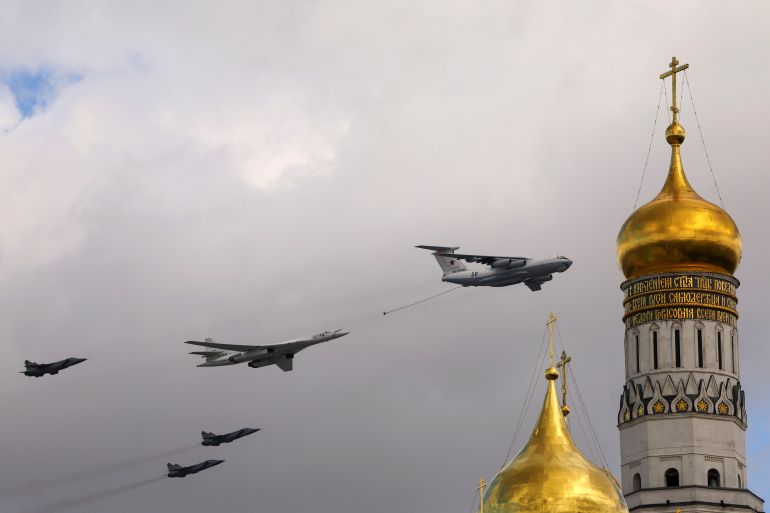
Kyiv, Ukraine – Called the White Swan, the Tu-160 is the world’s heaviest and fastest supersonic bomber.
The Soviet-designed flying fortress can circle half the globe, fly as high as 20km (12.4 miles) above Earth and carry 45 tonnes of bombs – or a dozen Kh-55 nuclear missiles.
Moscow has 16 White Swans and has been using them as trump cards in its renewed confrontation with the West.
In recent years, they have flown over the North Pole to violate US and Canadian airspace, landed in Venezuela and launched cruise missiles at Syria.
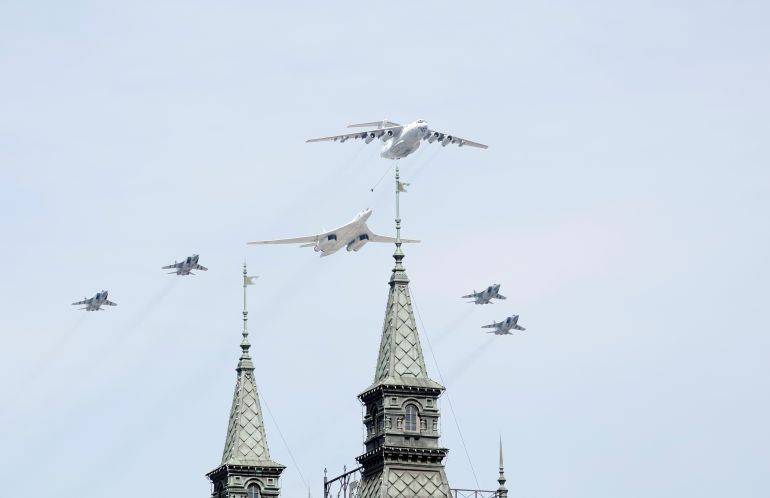 Russia has used the Tu-160 strategic bomber, centre, in attacks on Ukraine, which once had far more of the aircraft than its larger neighbour [File: Maxim Shemetov/Reuters]
Russia has used the Tu-160 strategic bomber, centre, in attacks on Ukraine, which once had far more of the aircraft than its larger neighbour [File: Maxim Shemetov/Reuters]Since last March, the White Swans have rained hell on Ukraine.
They take off from an airbase near the Volga River city of Saratov and launch non-nuclear missiles without entering Ukraine’s airspace.
And in what may come as a surprise, half of Russia’s White Swans once belonged to Kyiv – just like hundreds of missiles they can carry.
Obama’s visit
“In Donetsk, I stood among piles of conventional weapons that were slowly being dismantled,” Barack Obama, then a newly elected United States senator from Illinois, said in 2005 after his first foreign trip.
The future president visited the eastern Ukrainian city, the future hotbed of pro-Russian separatism, and helped secure $48m to fund the further destruction of 400,000 small arms, 1,000 portable anti-aircraft missiles and 15,000 tonnes of ammunition.
A local photographer named Sergey Vaganov took pictures of Obama in the arms depots.
A decade later, Vaganov fled a Russian-backed separatist conflict in Donetsk and, in March, barely survived the Russian siege of Mariupol.
“I was waiting for the relief [of death]. I had these half-suicidal thoughts,” Vaganov told Al Jazeera, describing how he and his wife, Iryna, waited out Russian air raids in their ice-cold apartment with windows shattered by shelling.
Obama’s visit to Ukraine was part of Western efforts to have Ukraine destroy its Cold War-era stockpiles of weapons – or to transfer them to Russia.
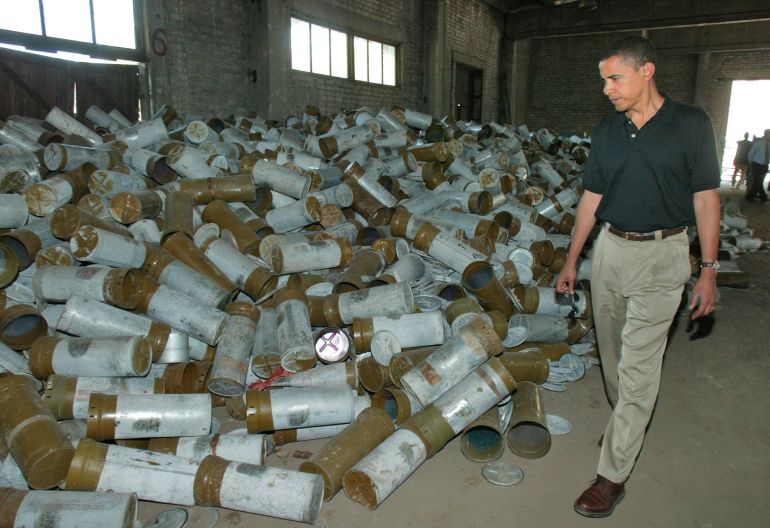 Then-US Senator Barack Obama inspects a pile of decommissioned weapons in a warehouse in eastern Ukraine’s Donetsk region in 2005 [File: Alexander Khudotioply TP/CVI/Reuters]
Then-US Senator Barack Obama inspects a pile of decommissioned weapons in a warehouse in eastern Ukraine’s Donetsk region in 2005 [File: Alexander Khudotioply TP/CVI/Reuters]Western pressure
After the 1991 collapse of the Soviet Union, Kyiv inherited a colossal arsenal, including nuclear weapons and 19 White Swans, which were based at the Priluky Air Base in northern Ukraine.
Russia had only two such bombers.
But maintaining strategic aircraft was unnecessary after Kyiv, along with all other former Soviet republics, gave in to Western pressure and “returned” thousands of nuclear warheads to Moscow.
Washington was predictably worried about nuclear arsenals in the 15 newly independent nations that emerged from the USSR as they were undergoing painful economic transitions, often along with political instability.
“Let’s remember the pressure the US exerted on post-Soviet nations to transfer all the carriers of nuclear weapons to Russia,” Igar Tyshkevich, a Kyiv-based analyst, told Al Jazeera.
In 1991, Kyiv said that within 10 years, it would get rid of all its heavy bombers, the missiles these planes could carry and the airfield equipment to maintain them.
Washington funded the destruction of 11 White Swans, 27 smaller Tu-95s, almost 500 air-launched cruise missiles, 130 SS-19 intercontinental ballistic missiles, their silos and launch-control centres.
And then there were the small arms, including AK-47 assault rifles and light weapons – about 7 million units in dozens of depots throughout Ukraine.
For years, Ukraine has also been getting rid of them – as well as air defence systems, ships and submarines.
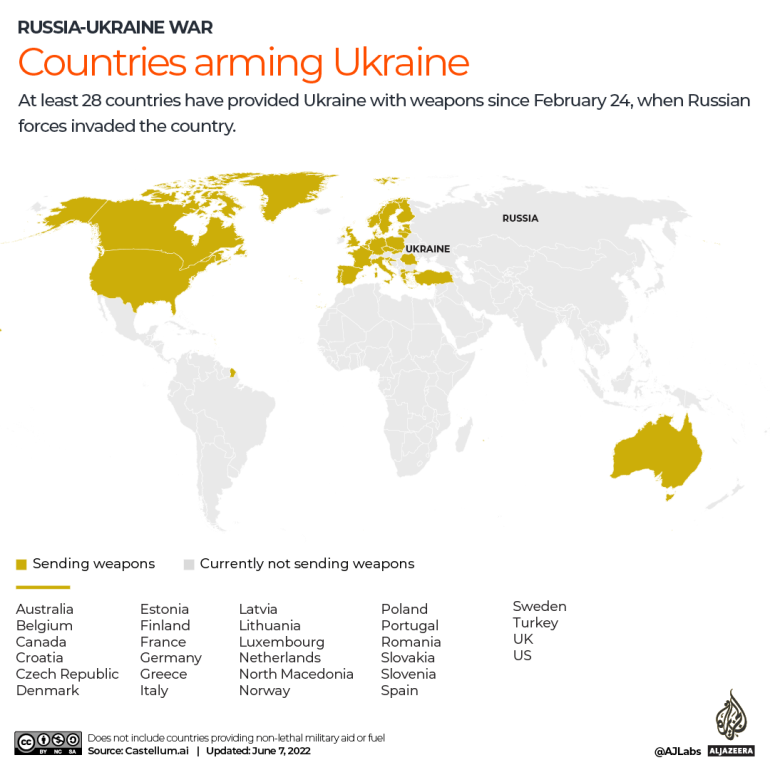
Buyers rush in
Libya, the United Kingdom and US bought hundreds of thousands of AK-47s, and Pakistan purchased 320 tanks from Ukraine.
The Varyag, a 300-metre-long (985-foot-long) aircraft carrier, was assembled in the southern city of Mykolaiv in 1988, sold to a Macau company for conversion into a floating casino a decade later and became China’s first carrier, The Liaoning.
But a sizeable chunk of Ukraine’s weapons were taken to Russia, mostly in the late 1990s and the early 2000s, as payment for Kyiv’s multimillion-dollar debt for natural gas.
The shipments included almost 575 Kh-55 subsonic missiles used on White Swans along with 386 Kh-22 missiles.
In 2022, Russia would use those Kh-55s against the very country that had sent them. Moscow removed their nuclear warheads added ballast as decoys to overload Ukrainian air defences during attacks on key infrastructure.
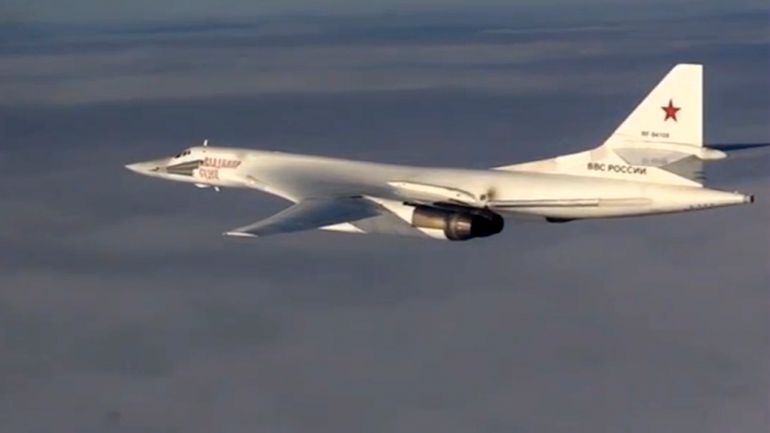 In this photo made from video taken from the website of the Russian Ministry of Defence, a Tu-160 bomber flies a combat mission in 2015 as part of a Russian air campaign in Syria [File: Russian Defence Ministry Press Service/AP]
In this photo made from video taken from the website of the Russian Ministry of Defence, a Tu-160 bomber flies a combat mission in 2015 as part of a Russian air campaign in Syria [File: Russian Defence Ministry Press Service/AP]By the start of 2000, Ukraine had only two TU-160s left, and on a cold January morning, it flew one of them to the Engels-2 Air Force Base in Russia.
The plane’s commander said the transfer was necessary to stop energy shortages in Ukraine.
“We saw blackouts, limited the use of [natural] gas, and our staffers, families of our pilots, felt the great shortages the entire nation felt,” Serhiy Osipov said in televised remarks in 2000.
The very last White Swan was stripped of its weaponry, engines and electronics and is anchored at an open-air aviation museum in the central city of Poltava.
Meanwhile, Russia produced six more White Swans and announced in late December that two more completed bombers are being tested.
‘Goodwill’
Today, Ukraine’s voluntary transfer of advanced weaponry to Russia seems absurd, but geopolitics was very different in the the post-Soviet world of the 1990s.
It was the “height of goodwill and cooperation between Russia and the West, and Ukraine as a buffer between the two was on good terms with both”, Maria Popova, associate professor at McGill University in Montreal, Canada, told Al Jazeera.
In 1994, Russia and the West signed a treaty that guaranteed Ukraine’s security and territorial integrity.
Three years later, Kyiv signed a comprehensive friendship treaty with Moscow and a partnership deal with NATO.
And in the early 2000s under President Vladimir Putin, who was then seen as a pro-Western Germanophile, the West considered Russia a flawed but fledgling democracy.
To boost his image, Putin appeared on Russian television riding on horseback, “piloting” a military submarine – and a Tu-160.
Ukrainian and Russian forces maintained close ties rooted in the common Soviet past.
“Four of my former classmates are in top positions in the Russian army,” Ihor Voronchenko told Al Jazeera in 2018 when he served as a Ukrainian admiral after studying at a military school in Soviet Uzbekistan. “We’re enemies now.”
But two decades ago, Kyiv could not possibly foresee a threat from Russia, and swapping arms for gas “seemed like a good idea”, Popova said.
The transfers were part of larger disarmament negotiations between Russia and the West.
“Ukraine, of course, was the weakest international actor of the three, so, yes, it was under pressure from both sides to be ‘a good sport’,” she said.
Nowadays, many in Ukraine regret the transfers, especially because they involved natural gas deals that have bred corruption in the halls of power for decades.
“This was a strategic mistake and political shortsightedness when political elites covered up their schemes and paid [Ukraine’s] debts by transferring strategic weaponry to Russia,” Aleksey Kushch, a Kyiv-based analyst, told Al Jazeera.
General Vadym Skribitsky, Ukraine’s deputy intelligence chief, told The New York Times in early December: “It would be better if we handed them over to the USA.”

‘Lend-lease’
In the early 2010s, pro-Russian Ukrainian President Viktor Yanukovych began a new wave of disarmament.
In 2013, his defence minister, Pavel Lebedev, decommissioned S-200V air defence systems that were used at five military bases.
He also ordered 1,000 portable air defence units destroyed as well as 1.5 million small arms and 133,000 tonnes of ammunition.
Yanykovych was toppled in 2014 after months-long protests.
Lebedev fled to Russia-annexed Crimea, where he began financing construction projects and quickly “became part of the Russian system”, anti-corruption activist Elena Yatsishina told Al Jazeera in 2015.
The destruction and transfer of weapons caused dire shortages in the Ukrainian army and led to a corruption scandal unprecedented even for Ukraine.
In 2019, an investigative report described how Ihor Hladkovskiy, the son of then-President Petro Poroshenko’s close ally Oleh Hladkovskiy, organized a scheme to smuggle used and often unusable military components from Russia and sell them to Ukraine’s military at extortionate prices.
The scandal tanked Poroshenko’s approval ratings, and he lost the 2019 election to rookie politician Volodymyr Zelenskyy.
Under Zelenskyy, Ukroboronprom, the state-run consortium of more than 100 arms producers, underwent radical reform.
It started churning out portable anti-tank missiles that proved lethal to advancing Russian forces and Neptune missiles, which sank Russia’s flagship, the Moskva, in April.
After the war started nearly a year ago, “arms transfers” saw a reverse trend.
Fleeing Russian soldiers abandoned hundreds of tanks, armed personnel carriers and artillery units, and Ukrainian servicemen fixed, repainted and started using them.
They call these acquisitions “lend-lease” after a US programme that provided arms and other military supplies to the Soviet Union during World War II
“We’re collecting whatever is useful in the field and will get them all back to the [Russian] side in the form of shells,” Ukrainian Ministry of Defence spokeswoman Natalia Humeniuk said in televised remarks in November.
No comments:
Post a Comment